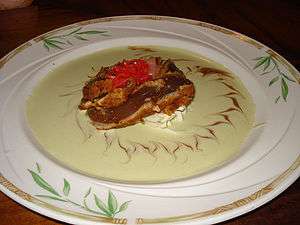Beurre blanc
Beurre blanc—literally translated from French as "white butter"—is a hot emulsified butter sauce made with a reduction of vinegar and/or white wine (normally Muscadet) and grey shallots into which, softened, whole butter is whisked in off the heat to prevent separation. The small amount of emulsifiers naturally found in butter are used to form an oil-in-water emulsion. Although similar to hollandaise in concept, it is considered neither a classic leading nor compound sauce.[1] This sauce originates in Loire Valley cuisine.

Origin
The chef Clémence Lefeuvre (née Clémence Prau) invented beurre blanc, apparently by accident, sometime around the beginning of the 20th century. She served this sauce at her restaurant "La Buvette de la Marine" in the hamlet of La Chebuette in the village of Saint-Julien-de-Concelles on the banks of the Loire River a few kilometers upstream from Nantes.[2]
Legend holds that she intended to prepare a béarnaise sauce to go with pike, but forgot to add the tarragon and egg yolks. Some sources claim that this invention occurred while she worked as a cook for the Marquis de Goulaine at Château de Goulaine.[3] Aristide Briand, long-time prime minister of France and Nobel Peace Prize laureate, said at her death in 1932 that it "was a bit like national mourning".[2]
Preparation
A good beurre blanc is rich and buttery, with a neutral flavor that responds well to other seasonings and flavorings, thereby lending itself to the addition of herbs and spices. It should be light yet still liquid and thick enough to cling to food also known as nappe.
Beurre blanc is prepared by reducing wine, vinegar, shallots, and herbs (if used) until it is nearly dry. Although not necessary, cream can be added at this point as a stabilizer to the sauce. Lemon juice is sometimes used in place of vinegar, and stock can be added, as well.[4] Cold, one-inch cubes of butter are then gradually incorporated into the sauce as the butter melts and the mixture is whisked.
The sauce can separate by either overheating or cooling. If it heats past 58 °C (136 °F), some of the emulsifying proteins begin to break down and release the butterfat they hold in emulsion. If the sauce cools below 27 °C (81 °F), the butterfat will solidify.[1]
Derivatives
Beurre rouge
Beurre rouge (English: "red butter") is a variant of the beurre blanc sauce that is prepared by substituting a dry red wine for the white wine and red wine vinegar for the white wine vinegar.[5]
- A potato and vegetable dish prepared with beurre rouge (red butter)
See also
References
| Wikimedia Commons has media related to Beurre blanc. |
- (1995), On Cooking, Sarah R. Labensky, Salan M. Hause, Priscilla A. Martel
- St-Julien-de-Concelles Official Website Retrieved 24 May 2008. Archived 18 November 2008 at the Wayback Machine
- Nantes' Quiz Archived 20 May 2011 at the Wayback Machine Retrieved 24 May 2008.
- Julia Child (1961), Mastering the Art of French Cooking, Alfred A. Knopf
- Rombauer, I. S.; Becker, M. R.; Becker, E.; Guarnaschelli, M. (1997). JOC All New Rev. - 1997. Scribner. p. 57. ISBN 978-0-684-81870-2.